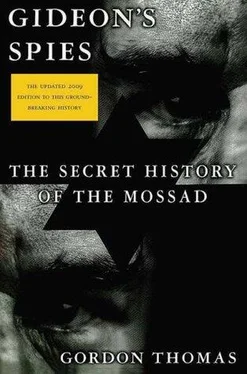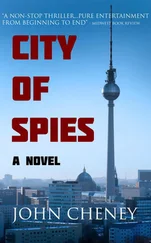Gordon Thomas - Gideon's Spies
Здесь есть возможность читать онлайн «Gordon Thomas - Gideon's Spies» весь текст электронной книги совершенно бесплатно (целиком полную версию без сокращений). В некоторых случаях можно слушать аудио, скачать через торрент в формате fb2 и присутствует краткое содержание. Город: New York, Год выпуска: 2009, ISBN: 2009, Издательство: Thomas Dunne Books, Жанр: История, на английском языке. Описание произведения, (предисловие) а так же отзывы посетителей доступны на портале библиотеки ЛибКат.
- Название:Gideon's Spies
- Автор:
- Издательство:Thomas Dunne Books
- Жанр:
- Год:2009
- Город:New York
- ISBN:978-0-312-53901-6
- Рейтинг книги:4 / 5. Голосов: 1
-
Избранное:Добавить в избранное
- Отзывы:
-
Ваша оценка:
- 80
- 1
- 2
- 3
- 4
- 5
Gideon's Spies: краткое содержание, описание и аннотация
Предлагаем к чтению аннотацию, описание, краткое содержание или предисловие (зависит от того, что написал сам автор книги «Gideon's Spies»). Если вы не нашли необходимую информацию о книге — напишите в комментариях, мы постараемся отыскать её.
Gideon’s Spies
Gideon's Spies — читать онлайн бесплатно полную книгу (весь текст) целиком
Ниже представлен текст книги, разбитый по страницам. Система сохранения места последней прочитанной страницы, позволяет с удобством читать онлайн бесплатно книгу «Gideon's Spies», без необходимости каждый раз заново искать на чём Вы остановились. Поставьте закладку, и сможете в любой момент перейти на страницу, на которой закончили чтение.
Интервал:
Закладка:
The meeting attendees then went on to discuss the risks associated with such an attack. The details were subsequently obtained by the author and are published here for the first time. The meeting attendees were told that an American-led attack could trigger “devastating reprisals” against the 8,500 British troops based in Iraq and the 4,000 British soldiers who had arrived in Afghanistan. Ehrman reminded them that both countries had strong religious and political ties to Iran. Walker predicted the attack might be preceded by Washington reorganizing its plan to withdraw a substantial number of troops from Iraq. It would also certainly lead to confrontation with China and Russia—whose support would lead to Iran cutting off its oil supplies to the West. Scarlett cited Meir Dagan’s view that the offensive on Iran would see a dramatic increase in suicide bomber attacks against Israel. The intelligence chief added that MI6 intelligence could provide no guarantee that an aerial assault on Iran would destroy the eight identified targets the Pentagon designated. These targets were:
• Saghand, a mining operation set to begin later this year, yielding fifty-to-sixty tons of uranium annually.
• Ardkan, where ore is purified to produce uranium ore concentrate known as yellowcake.
• Gehine, a mining and milling facility.
• Isfahan, where yellowcake is cleansed of impurities and converted to uranium hexafluoride gas.
• Natanz, an enrichment site, which can be used to produce weapons-grade uranium.
• Tehran, a research reactor and radioactive waste storage facility.
• Bushehr, a Russian-built light water reactor.
• Arak, a heavy water research reactor.
• Anarak, a nuclear waste storage site.
No date had yet been fixed for an air attack, but if Iran continued its bellicose attitude and ignored demands made by the UN, the Bush administration could launch military action in 2007, but possibly not later than the run-up to Bush’s final year in office in 2008. The present mission plans were two-phased. Cruise missiles would destroy defenses around the targets, then B2 stealth bombers would strike their plants with bunker-busting bombs. The Pentagon estimated the total mission time in the target areas at probably eight hours. Submarines would simultaneously launch rockets.
The meeting studied the latest intelligence on Iran’s current ballistic missile capability: a total of eighty-five S-300 air defense missiles. Provided by China, they would be effective against U.S. fighter-bombers, less so against the multi-defense systems of the Tactical Tomahawks. There were also forty X-55 cruise missiles, each with an estimated range of over one thousand miles. They were based close to the border with Turkmenistan. Less than thirty Shabtai-3 rockets provided by China and based in sites in southern Iran bringing them well within range of Israel. The Shahab-4 rocket was currently being developed near Natanz, south of Tehran. Present intelligence estimates said it would not come on line until 2008. Each would have a range of eight thousand miles—able to strike against anywhere in Europe and the United States. The present missiles could be adapted to fire from Iran’s twenty-five missile crafts and its three frigates. None, however, could be launched from Iran’s air force of two hundred aging aircraft: Tomcats, MIG-29 Fulcum, and Phantoms. Iran’s five hundred thousand army of regulars and conscripts were poorly led and trained. Most of their equipment comes from the former Soviet Union.
The meeting then turned to a lengthy discussion of who, apart from the Blair government and Israel, would support a U.S. attack. The conclusion was that diplomatic support within the European Union would probably only come from Poland.
What the meeting did not know, and which would only emerge in August 2006 (through Seymour Hersh, an investigative journalist), was that President Bush and Vice President Cheney had proposed using nuclear weapons to destroy the uranium enrichment plant at Natanz. The plan had been fiercely opposed by the Chairman of the Joint Chiefs of Staff, Marine General Peter Pace. He and other Pentagon commanders, at an equally secret meeting warned Bush and Cheney of what they saw as “the serious economic, political, and military consequences. A military strike on Natanz would vent fatal radiation for three hundred kilometers.” This would include Tehran and its multi-million population. The Pentagon chiefs argued for dropping the “largest possible bunker bombs available in a multi-drop attack which would generate sufficient force to accomplish what a nuclear warhead would achieve, but without provoking an outcry over what would be the first use of a nuclear weapon in conflict since Nagasaki.”
The chance of success by such an attack was challenged. A Pentagon adviser argued that such an attack “would be like bombing water, with its currents and eddies. The bombs would likely be diverted.” More certain was that such an attack would be seen throughout the Muslim world as another example of American imperialism and would lead to unprecedented retaliation. Already the growing prospect of such retaliation had come to preoccupy the intelligence services of Britain, Mossad, the CIA, and the Pakistan intelligence service. The threat was centered on a plot, that if successful, would lead to the greatest terrorist outrage the world had ever known.
Since March 2006, Operation Overt had become the largest, most secret and widespread surveillance and intelligence operation ever mounted in Britain, post-WW II. It had quickly widened to include Scotland Yard’s anti-terrorism squad and its special branch, GCHQ, Britain’s spy in the sky, NSA, its counterpart in the United States, the CIA and the FBI, the DSGE in France, Germany’s BND, the Pakistani intelligence service and Mossad.
In all some five hundred of the world’s most experienced spies were involved in an operation aimed at two British-based cells of suspected Islamic militants who were believed to be plotting a massive terrorist attack. How it would be carried out, the target, and its time and place were still unclear in late May 2006.
For weeks the intelligence teams had been patiently gathering the tentacles that had emerged from suspects uncovered in the “concentric circles” which materialized after the London bombings in July 2005. The first cell had been pinpointed after one suspect had returned from an al-Qaeda training camp in the “badlands” of northern Pakistan. The second cell had been identified as operating out of the Muslim community in the suburbs of south London. Both cells were placed under intense monitoring. All public meetings in both areas were infiltrated by MI5 officers. Telephone contacts by those who attended the gatherings were traced to Paris, Frankfurt, and, as one anti-terrorist officer later said, “to all points East and West.” E-mails were intercepted by GCHQ and NSA. From listening posts on the island of Cyprus to the deserts of Afghanistan, the mountains of Iran, and the North West Frontier border of Pakistan, the words of cell members and their associates were plucked out of the air, recorded, and sent to the Joint Terrorism Analysis Centre (JTAC) in London’s Millbank. Its Anacapa wall charts—specialist diagrams to create a coherent picture from all the incoming information—were constantly updated.
In the world outside, other stories came and went in the headlines. One was the assassination of Abu Musab al-Zarqawi, the murderous leader of al-Qaeda in Iraq. In late June 2006 his hideout near Baghdad was devastated by a laser-bomb attack. He had tried to crawl to safety, but had been shot by U.S. Special Forces. They were led to al-Zarqawi by a whistleblower in his midst. The man received “a very substantial payment” and was given a new identity in a country of his choice. He was assured its whereabouts would forever remain a secret.
Читать дальшеИнтервал:
Закладка:
Похожие книги на «Gideon's Spies»
Представляем Вашему вниманию похожие книги на «Gideon's Spies» списком для выбора. Мы отобрали схожую по названию и смыслу литературу в надежде предоставить читателям больше вариантов отыскать новые, интересные, ещё непрочитанные произведения.
Обсуждение, отзывы о книге «Gideon's Spies» и просто собственные мнения читателей. Оставьте ваши комментарии, напишите, что Вы думаете о произведении, его смысле или главных героях. Укажите что конкретно понравилось, а что нет, и почему Вы так считаете.












